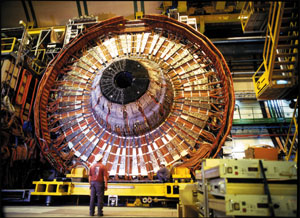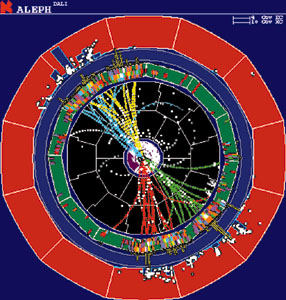CERN’s LEP electron-positron collider closed last year after a tantalizing and controversial finish, which revealed hints of the long-awaited Higgs particle – the missing link in today’s picture of particle physics.

“Season of mists and mellow fruitfulness,” wrote the English poet John Keats (1795-1821) in his famous ode “To autumn”. At CERN, the autumn of the year 2000 brought a very different scenario.
During the latter months of 2000, CERN Courier‘s news coverage followed the progress of the experiments at the LEP electron-positron collider as its energy was pushed to unprecedented and unforeseen levels. In the lead-up to the ultimate closure of LEP, several experiments produced some interesting evidence for the long-awaited Higgs particle – a keystone of modern physics theory.
Originally scheduled to close in September 2000, LEP was given a six-week “stay of Higgs execution” so that it could investigate the candidate Higgs signals further. Some additional evidence was found during the extra running time, but not enough to claim a discovery. With the need to commence construction work for CERN’s LHC collider (to be built in the same 27 km tunnel as LEP) becoming increasingly urgent, the decision was finally taken to close LEP for good.
A brief history of LEP

CERN’s 27 km LEP storage ring was built with the initial objective of making precision measurements on the Z particle (the electrically neutral carrier of the weak force discovered at CERN’s proton-antiproton collider in 1983). For this, LEP had energies of about 45 GeV per electron and positron beam when it began operations in 1989.
However, LEP was designed to explore much more than just the Z particle. Even before the machine was formally approved for construction in 1981, a far-sighted programme of research and development had begun to develop superconducting radiofrequency cavities, which would boost the machine’s beams towards 100 GeV per beam and probe far beyond the Z production threshold.
By 1996 the necessary technology had been established and LEP was equipped with a number of gleaming new niobium covered accelerating cavities. By 1998, 272 of these cavities had been installed in the machine, and the collision energy (the sum of the two colliding beam energies) had attained 189 GeV. This was more than enough for LEP to start seeing production of the W particle, the electrically charged companion of the Z (in electron-positron collisions the W has to be produced in oppositely charged pairs).
By the beginning of its 1999 run, LEP had been equipped with an additional 16 superconducting cavities, bringing the collision energy to 192 GeV. The supercavities lived up to their name and soon began providing accelerating fields greater than the 6 MV m-1 originally planned, and in the summer of 1999 the machine delivered its first 100 GeV beams.

The ultimate goal is to find the missing link in today’s Standard Model picture of particle physics: the Higgs particle, which breaks the underlying electroweak symmetry and makes everyday electromagnetism look very different from weak interactions, ensuring that light and nuclear beta decay look so different that it took most of the 20th century for the connection between them to be recognized.
The Higgs endows particles with mass, so that the photon carrier of electromagnetism is free to roam, while the weak interaction is mediated by very heavy particles which are confined to subnuclear dimensions. Unfortunately the electroweak theory makes no direct prediction as to what or even where the Higgs may be.
However, the quest is not entirely unguided. All of the parameters of the electroweak theory have to fit together in a consistent way. As these parameters were measured with increasing precision, the region in which the Higgs had to lie became progressively smaller.
By 1999 it had become clear that LEP was operating in the very collision energy region in which the Higgs was most likely to be found. Eagerly, the teams working on the four experiments – Aleph, Delphi, L3 and Opal – scrutinized their new data.
In the mutual annihilation of an electron and a positron, the Higgs particle could emerge back to back with a Z particle. The possibility had been pointed out long before in several prophetic papers, the first published in 1976 by John Ellis, Mary K Gaillard and Dimitri Nanopoulos at CERN.
Shakespeare wrote: “Rumour is a pipe blown by surmises, jealousies, conjectures…that…the still-discordant wavering multitude can play upon.” By the autumn of 1999 the first of such whispers were heard about the Higgs, first in CERN corridors, then on the Internet. Behind the scenes, the CERN publicity machine began to compile material for a Higgs announcement, just in case.
Physicists at CERN report the progress of their experiments via special platforms, in this case the public sessions of the LEP Experiments Committee. Normally held a few times per year, these sessions were traditionally opened by representatives from the machine operations team, who would give the latest news on the machine front, followed by a slot for each of the four major experiments to present their latest findings.
The meeting on 9 November 1999 was particularly well attended, due to the rumours that abounded about the Higgs. However, in spite of these rumblings, nothing new emerged in public that day on the Higgs front.





